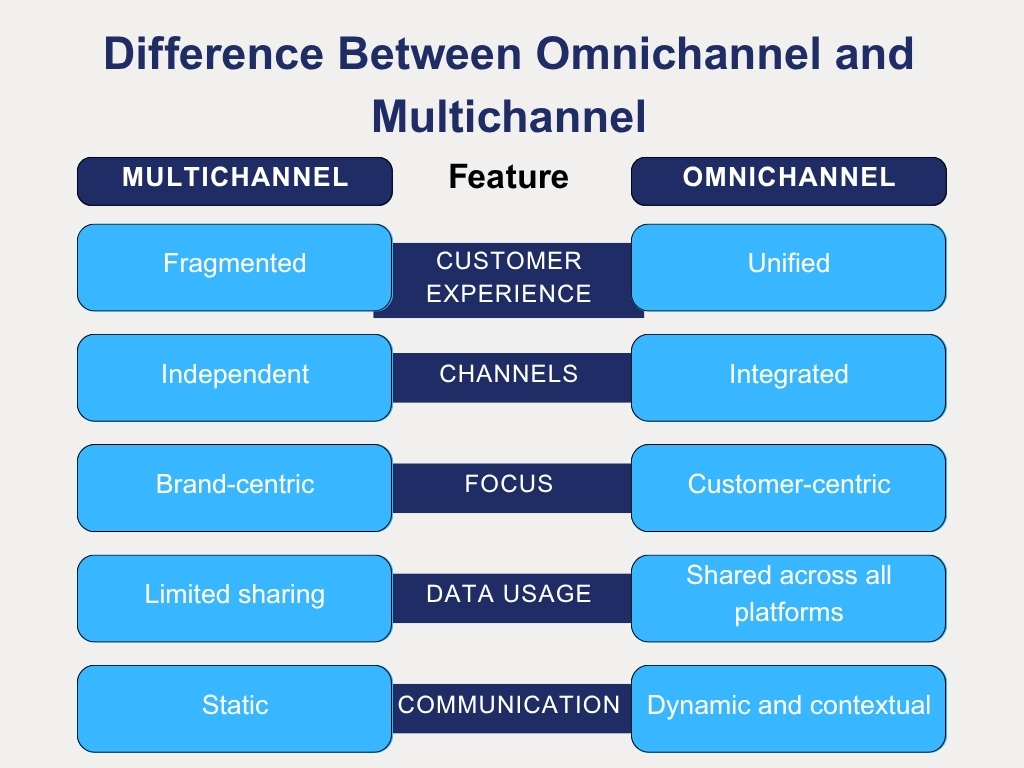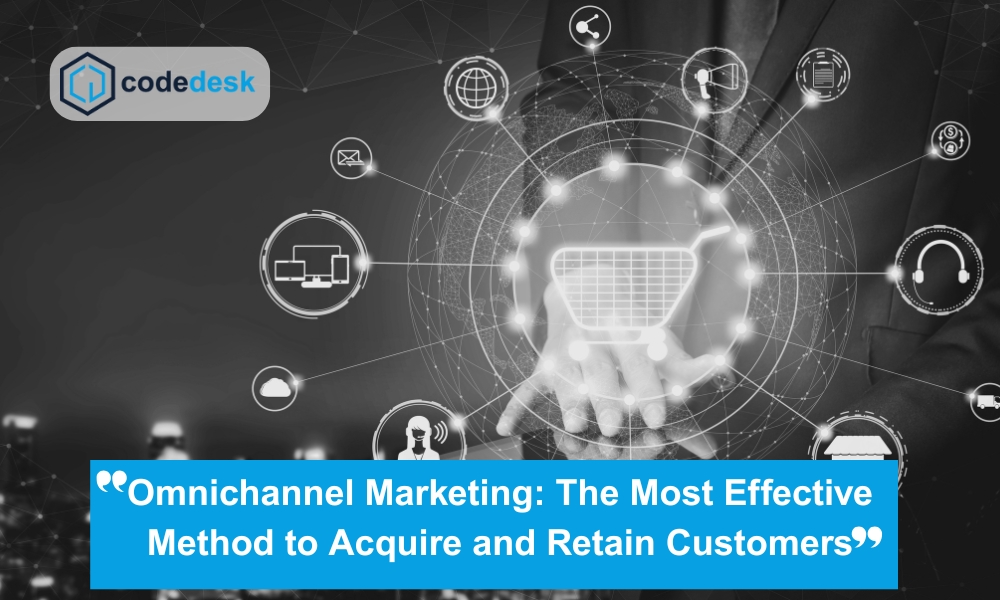Ever entered a retail store, saw something you liked, but left without purchasing, only to have an ad for it appear later on your mobile device or laptop? That’s no sorcery—it’s omnichannel marketing working its magic. And for businesses that have yet to implement it, mark my words, you are missing out on revenue and customers.
In this blog, we will explore the definition of omnichannel marketing, discuss its importance, and guide you through crafting an easily automated strategy that appears ethereal to clients, while generating tangible outcomes for your brand.
What Is Omnichannel Marketing, Really?
Let’s simplify things. Omnichannel marketing refers to responsiveness and delivering a seamless and consistent customer experience across various touch points including your website, mobile application, social media platforms, emails, and physical store. Unlike multichannel marketing, where individual silos exist in each channel, omnichannel integrates everything. It’s customer-centric as it focuses on the customer’s needs and preferences.
Illustration in Motion:
A customer visits your site using a laptop. They add an item to their cart but get distracted and close the tab. Later, they receive an email notification reminding them of the abandoned product. Out of curiosity, they open the email on their mobile device, where they click through to the app that conveniently retains the cart. Finally, they go to your physical store and are served custom marketing based on their web activity – same brand, same product, same price. That’s omnichannel: all touchpoints working together to deliver custom-tailored customer interaction.
Why You Should Care About Omnichannel Marketing In 2025
Consumers don’t distinguish between different aspects of your business. They want seamless interaction. Here’s the thing: your customers expect you to remember anything they’ve discussed with you across all platforms—from Instagram to email or through a chatbot, and for the conversation to continue seamlessly.
And the statistics are proof:
- Companies with strong omnichannel strategies retain 89% of their customers, compared to 33% for companies with weak ones.
- Omnichannel campaigns earn 18.96% more engagement, on average.
- Customers who interact with multiple channels spend up to 30% more than those who stick to one.
Difference Between Omnichannel and Multichannel
Let’s break it down simply:

Bottom line? Multichannel is like having a band where every musician plays their own tune. Omnichannel is the full orchestra playing in harmony.
The Central Features of an Omnichannel Strategy
What exactly does an omnichannel experience derive From? These are your requirements:
1. Prioritized Customer Information
You won’t be able to Dop anything without understanding your customer. Gather information at various touchpoints like email opens, social interactions, purchases, and website visits, and centralize it within a CRM.
2. Unified Communication Across All Touchpoints
No matter where your audience interacts with your business, be it TikTok or your newsletter, the offers, voice, tone, branding, and everything else should be the same. Consistency aids in earning customer trust, which takes a lot of effort.
3. Integration of Devices and Channels
A customer using a computer, smartphone, or visiting a physical location should have a seamless experience. If they bought something using mobile, it should be awaiting for them on desktop.
4. Personalized at Volume
Similar to how Netflix suggests programs and Amazon tracks what users search for, businesses need to remember what their clients want. Automated systems with AI should deliver relevant communications aligned with user interactions through segmentation.
5. Unified for All Departments
Sales, marketing as well as customer support, and logistics have to silo work to collaborate together. Omnichannel approaches need external cohesion, but internal coordination as well.
Best Channels That Enhance the Omnichannel Experiences
Let’s take a brief glance at what best fits omnichannel marketing strategy:
- Email Marketing
By far the most effective channel. Ensure that there are ongoing conversations with customers through behavior-driven emails like view products, purchase, and follow-up emails.
- Social Media
Youtube is not the only one monetizing content. Facebook, Instagram, LinkedIn, and TikTok can serve as channels for responding to queries, serving, and advertising to customers.
- Live Chat and Chatbots
Talk about instant responses. Use a mixture of human agents and automated chatbots to answer questions and provide guidance no matter what device the user is switching through.
- Mobile Apps
In-app communication is simpler than ever with push notifications, loyalty rewards, and in-app messages.
- In-store Experiences
Use mobile point of sale systems, qr codes and buy online pick up in store to enhance traditional retail interactions.
Successful Brands That Use An Omnichannel Strategy
Look how some top brands nailed it.
- Starbucks: The app allows customers to order ahead, collect loyalty rewards, reload, and redeem perks in stores, online and in-app. Everything syncs perfectly
- Disney: From browsing trips online to using magicbands in the parks, Disney offers fairy tale level omnichannel experiences that flows seamlessly.
- Sephora: Translate and redeem their Beauty Insider program rewards seamlessly across store and website.
Creating Your Own Personal Omnichannel Marketing Approach: Step by Step
Learn how to implement a single focused marketing approach that is aimed towards the customer and interlinks all the channels of your businesses.
Step 1: Plan The Customer Journey
Map out customer pathways from awareness to purchase. Which stages lead towards the goal and where is the drop off? Tools here include Google Analytics, Hotjar, customer surveys, and even interviews.
Step 2: Choosing The Correct Options
Not every channel applies for every business. Focus on your business’s target audience and these are either B2B in which case email and LinkedIn are useful or figuratively B2C type businesses via Instagram and TikTok.
Step 3: Integrate Technology Suite
Merge your CRM, email marketing applications, social platforms, and even analytics for a consolidated view of the customer. Achieve a single view of your customers for more effective analysis.
Step 4: Personalize Offers
Employ marketing automation to send targeted messages including relevant catalogs, specials, based on their interests along with content tailored heavily to their browsing preferences to ensure engagement. Clients will expect that from associated businesses.
Step 5: Improve By Measurement And Optimization
Monitoring engagement with individual channels, measuring open rates along with conversions, and active participation is crucial in refining strategy. Omnichannels are integrated into ecosystems to work seamlessly for enhanced performance and superior results.
Want someone to do it for you instead? Codedesk provides the Best solutions for all your Digital Marketing problems.
Avoid These Omnichannel Mistakes
- Even large corporations make blunders from time to time. Here’s what to avoid:
- Not cohesive brand voice or messaging branding across multiple channels
- No response or follow-up to customer engagement
- Failing to integrate and consolidate online and offline data
- Using outdated tools that don’t integrate
- Treating all customers the same
Remember: your customer should never feel like they’re talking to a different company just because they switched platforms.
What Lies Ahead for Omnichannel Marketing?
It’s personal. It utilizes AI. It’s everywhere. Brands can now use AI, automation, and predictive analytics to deliver what customers want even before they ask. Anticipate smarter product recommendations, hyper-personalised email flows, and real-time interactions driven by customer behaviour.
The digitization of physical stores is also taking place with smart shelves, QR code shopping, and virtual assistants all coming to existence. Everything is going towards the consolidation of the physical and digital world into one holistic brand experience.
Final Thoughts: You Can No Longer Avoid Omnichannel
To unlock growth, customer retention, and brand loyalty, omnichannel marketing is no longer a convenient add-on. It is a necessity. In 2025, the brands that will be winning will be the ones that make their customers feel appreciated, embraced, understood, and deeply valued across all touchpoints. Start smart, start small, but start now. The perception of “getting” the customer stems from understanding their needs, will lead to enduring customer relationships.
Do you require assistance in building a marketing plan that integrates all channels and truly works? Let’s have a conversation. It will be our pleasure to partner with you in creating strategies that place your brand ahead of the curve, at all times, where your customers need you. Visit Today https://code-desk.com/services/top-digital-marketing-agency-uk/




